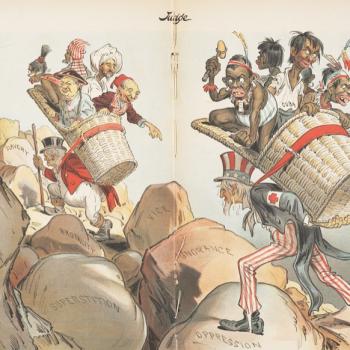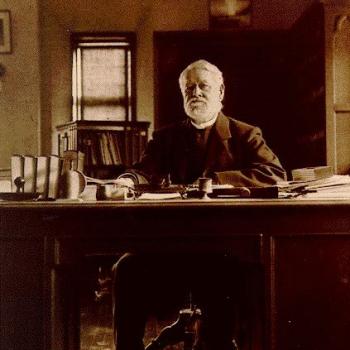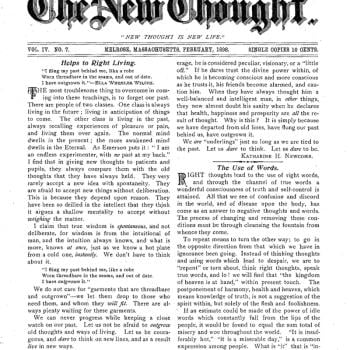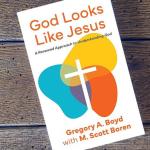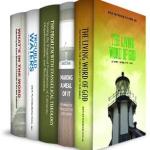I wrote last time about the failings of prophecy in predicting religious futures. Here is a case-study.
In his day, Ray Stannard Baker (1870-1946) was an enormously respected writer and journalist, and a highly intelligent observer of American life. He was a mainstay of the muckraking movement and a leading Progressive, who was close to Woodrow Wilson. His 1908 book Following the Color Line was a pioneering exploration of American racial conditions. In 1910, he published a survey of contemporary American religion called The Spiritual Unrest, which is incredibly informative, and a priceless historical source, but today it reads – well, oddly. Just how oddly perhaps raises alarming questions about how well we see the seemingly unmistakable trends going on around us.
Bear with me on this, I will explain the mystery as we proceed.
To put the book in context, let us recall what was happening in the decade or so before US entry into the First World War, a period that has a claim to be one of the most fertile and creative of American religious history. The best-known event today was the Azusa Street Revival of 1906, which launched the Pentecostal movement. But evangelical and charismatic movements were widespread in these years. A mighty evangelical revival found its anthems in such legendary hymns as “The Old Rugged Cross” and “In the Garden” (both from 1912). The Church of the Nazarene emerged from the Holiness movement in 1907-8, and the Assemblies of God date from 1914.
Dispensationalism was popularized worldwide by the reference Bible published in 1909 by American Cyrus Scofield, one of the most influential religious texts of the twentieth century. The Scofield Reference Bible offered a complete scriptural text with luxuriant annotations and cross-references. It explained how every individual portion of the book presented a single and coherent theological system that culminated in the approaching end times, and Armageddon was very close. The Watch Tower movement – predecessor of the Jehovah’s Witnesses – warned of the world ending very soon, in 1914.
The larger evangelical movement placed the language of blood and atonement, sacrifice and national righteousness, firmly on the nation’s cultural and political agenda. Activists intervened forcefully in secular politics through campaigns to enforce public morality and (especially) alcohol prohibition. The Temperance movement became a national crusade. Already by 1918 observers were mapping America’s Bible Belt.
But we can see other trends at work as well. In 1908, Walter Rauschenbusch published The Social Gospel. 1910 marked the World Missionary Conference at Edinburgh in Scotland, which raised hopes of converting the world to Christianity within a generation, and thereby creating the conditions for Christ’s coming. Meanwhile, debates over Bible criticism continued to roil many churches. Between 1910 and 1915, the Bible Institute of Los Angeles published The Fundamentals, the series of pamphlets that gave its name to Fundamentalism.
I could give lots more examples here, but the point is clear. This was a truly exciting time in American religion, and that is just looking at Protestant Christianity. Catholics and Jews also had their own debates and controversies. So much was happening!
So against that background, what did a brilliant man like Ray Stannard Baker find worthy of mention in 1910? What spiritual unrest was he talking about?
At first, his book seems to promise a sweeping and far-reaching analysis. The book’s epigraph quotes William James writing in 1907, and proclaiming that “It is quite obvious that a wave of religious activity, analogous in some respects to the spread of early Christianity, Buddhism, and Mohammedanism, is passing over our American world.” So what exactly is he talking about? Pentecostalism, surely. Or fundamentalism, or evangelicalism, or… what exactly?
Here are the book’s contents, with the list of chapters:
1.A Study of Trinity — the Richest Church in America 1
II. The Condition of the Protestant Church 49
III. The Disintegration of the Jews — A Study of the Synagogues of New York City 101
IV. The Slum Mission and the Institutional Church: A Comparison of Their Functions 142
V. Healing the Sick in the Churches — An Account of the Emmanuel Movement 183
VI. The Faith of the Unchurched: Inspirations From Outside the Church 232
VII. A Vision of the New Christianity — An Account of Professor Walter Rauschenbusch and his work …. 260
OK, I see the Social Gospel mentioned in his last chapter, but what about the rest? Baker tackles a number of controversies, including the dilemma of New York’s immensely rich Trinity Church, in an epoch of poverty, and he notes the sharp decline of religious attendance and participation across the board, for Christians and Jews, and especially in urban settings. And my, these problems from a century ago sound familiar today:
Uncounted Americans whose ancestors looked to the church as the chief inspiration of their daily existence no longer attend any church. Other thousands, though still nominally members or attendants, have ceased to admit the church or its ministers as a really vital influence in their lives. … Able young men do not go into the ministry as they once did; last year there were seven hundred fewer students in fifty-eight Protestant theological seminaries than there were twelve years ago. Ministers generally are under-paid and often disheartened with the prevailing apathy and neglect. Many churches, especially in the east, stand empty and deserted.
All these are valuable topics, and they are well studied. But what, for Heaven’s sake, is this wider unrest, what is the wave of religious activity sweeping the nation, and comparable to the rise of Christianity and Islam? I doubt if any non-specialist would get the answer today. For Baker, as for James, and plenty of other intellectuals at the time, the great religious movement about to sweep the world was not Pentecostalism, which was not even mentioned in the book, but… the Mind Cure movement, and specifically New Thought. As it is so all-but-forgotten these days, I borrow the Wikipedia definition for convenience:
The concept of New Thought (sometimes known as “Higher Thought”) promotes the ideas that Infinite Intelligence, or God, is everywhere, spirit is the totality of real things, true human selfhood is divine, divine thought is a force for good, sickness originates in the mind, and “right thinking” has a healing effect.
As Baker wrote, the great force in modern spirituality was “the new idealism”:
The new idealism lays its emphasis upon the power of mind over matter, the supremacy of spirit. Its thinkers have interested themselves as never before in the marvelous phenomena of human personality, most of which were contemptuously regarded by the old materialistic science. The wonders of the human mind, the attribute we call consciousness, the self, the relation of mind to mind, telepathy, the strange phenomena of double or multiple consciousness, hypnotism, and all the related marvels, are now crowding for serious attention and promise to open to us new worlds of human knowledge.
Now, every great philosophical and scientific movement has its popular and practical reflex. Just as the spread of the materialistic philosophy in the last century was accompanied the world over by a wave of infidelity and agnosticism, among the people, so the present wave of idealistic philosophy finds expression in a number of most remarkable popular movements. Every philosophy has its correlated faith; the faiths of the materialistic nineteenth century were pessimistic, negative, deterministic, while the new faiths are optimistic and positive. “I do not” and “I cannot” are superseded by “I do,” “I know,” “I will.” They are expressed in the spreading and significant Christian Science and New Thought movements, in the rise to power of leaders of the type of Dowie, in the revival of interest in spiritualism as a religion, in the idealistic side of socialism. At the very time that the philosophers and psychologists were thinking their way to the new philosophy, P. P. Quimby and Henry Wood and Mrs. Eddy and Dowie and many others were feeling their way toward new popular faiths. The world was weary of the old materialism, and the revolt, which some men reasoned out while others only felt, came alike to all.
Hence his detailed focus on the Emmanuel Movement, an Episcopalian attempt to provide medical healing within the framework of the church, in order to provide a counterweight to Christian Science. It offered a kind of pre-psychotherapy that did much to establish the practice of group therapy, and laid the groundwork for later movements to cure alcoholism and addiction.
I’ll talk more about New Thought in my next column, but here, let me just remark how absolutely, wildly wrong Baker was in his predictions. Living as he was during one o the great revivals in American history, he missed it entirely. Mind over matter, telepathy and hypnotism? Really?
Why does Baker get it so wrong? The obvious answer is that his examples and materials are so wholly focused on New York and a couple of other northeastern big cities. Remember the famous cartoon of the “New Yorker’s view of the world”? That was him.
Ironically, J. A. Dowie has left perhaps the most lasting of any of these spiritual leaders, as his church became the inspiration for the very strong Zion Christian Church, in South Africa – not a New Thought sect, but a Zulu Pentecostal body.
Let that be a warning to all would-be prophets. As the phrase goes, “Prediction is very difficult, especially about the future.”
Or to quote a sentence I like from H. G. Wells (of all people!), “Self deception is the anesthetic of life, while God is carving out our beings.”



